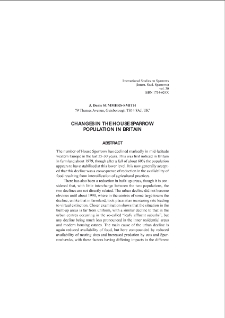Digital Library of Zielona Góra contains 63 423 digital objects
Object
Title: Changes in the house sparrow population in Britain
Group publication title:
Abstract:
The number of House Sparrows has declined markedly in mid-latitude western Europe in the last 25-30 years. This was first noticed in Britain in farmland about 1979, though after a fall of about 60% the population appears to have stabilised at this lower level. It is now generally accepted that this decline was a consequence of reduction in the availability of food resulting from intensification of agricultural practices. ; There has also been a reduction in built-up areas, though it is considered that, with little interchange between the two populations, the two declines are not directly related. The urban decline did not become obvious until about 1990, where in the centres of some large towns the decline, unlike that in farmland, took place at an increasing rate leading to virtual extinction. Closer examination shows that the situation in the built-up areas is far from uniform, with a similar decline to that in the urban centres occurring in the so-called "leafy affluent suburbs", but any decline being much less pronounced in the inner residential areas and modern housing estates. ; The main cause of the urban decline is again reduced availability of food, but here compounded by reduced availability of nesting sites and increased predation by cats and Sparrowhawks, with these factors having differing impacts in the different built-up habitat types. The House Sparrow is a social species, breeding in loose colonies, which depend on social stimulation for successful breeding. ; It is suggested that, when the colony size falls below a certain level, the birds cease to breed because of the lack of social stimulation and the colony collapses (the "Allee Effect"). This stage has been reached in the centres of some large towns, where lack of nesting sites has been the critical factor, and in the "lafy suburbs", where the separation of the buildings on which the birds prefer to nest leads more rapidly to lack of social stimulation than in the case of the other residential areas where the houses are much closer together. Any decrease in these latter areas has occurred though an increased spacing of the colonies rather than by a decrease in colony size.
Publisher:
Zielona Góra: University of Zielona Góra, Institute of Biotechnology & Environmental
Format:
Resource Identifier:
Pages:
Source:
International Studies on Sparrows, vol. 30
Language:
Rights:
Biblioteka Uniwersytetu Zielonogórskiego
Object collections:
- Digital Library of Zielona Góra > Repository > Faculties > Faculty of Biological Sciences
- Digital Library of Zielona Góra > Repository > Types of work > Articles
- Digital Library of Zielona Góra > Repository > Scientific journals and UZ publishing series > International Studies on Sparrows
Last modified:
May 23, 2023
In our library since:
Apr 28, 2023
Number of object content hits:
320
All available object's versions:
https://zbc.uz.zgora.pl/publication/81524
Show description in RDF format:
Show description in OAI-PMH format:
| Edition name | Date |
|---|---|
| Changes in the house sparrow population in Britain | May 23, 2023 |
Objects Similar
Laet, Jenny De Summers-Smith, Denis J. Mallord, John
Dilip Clinton, Samson Arockianathan Ramakrishnan, Balasundaram Samson, Arockianathan Karthick, Sivaraj Girikaran, Prabakaran Deepan, Ravi
Gokulakrishnan, G. Sivaperuman, C. Narayana, B. Laxmi
Jędro, Grzegorz Jędro, Magdalena
Zawadzki, Grzegorz Jackowiak, Mateusz Zawadzka, Dorota

